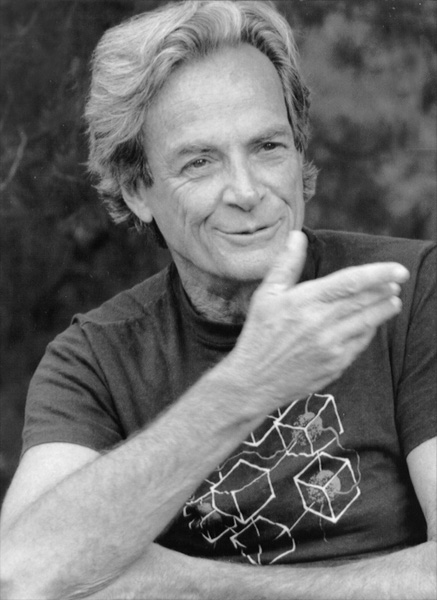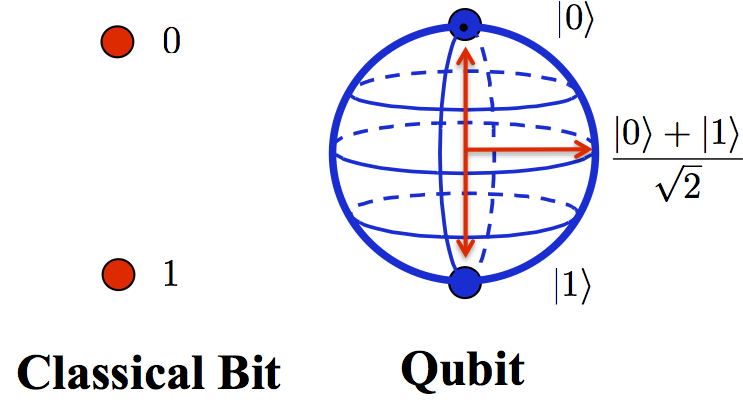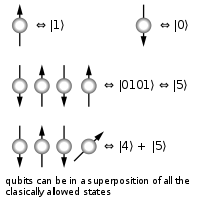 |
The column of equipment for a
quantum computer
(NY Times, May 2013) |
Quantum computing is still a very young technology. It was kicked off by a paper written by Richard Feynman in 1981 in which he theorized computations could be made much faster using the odd properties of quantum mechanics. Very little physical progress was made until the early 2000’s, in which a handful of early, weak quantum processors were developed. Nearly all of this research and development had been achieved through government and university laboratories. These early quantum computers consisted of very few qubits (those will be explained later) compared to today's processors. In the late 2000’s development of quantum computers really began to speed up. More processors were made each year, with the next having more qubits than the one before it. In 2011 the company D-Wave released the first commercially available quantum computer; this processor included 128 qubits. There has been a large amount of controversy surrounding quantum computing, especially D-Wave. Tests administered on these computers have had mixed results, sometimes getting an answer faster than classic computations, sometimes taking much longer. Currently the most advanced quantum computer is the D-Wave Two, boasting 512 qubits. Companies and universities around the world are itching to test this new technology and are willing to pay the hefty price to get their hands on one. Many experiments and papers are being made throughout the country as researchers continue to investigate the nebulous depths of quantum computers.
 |
Richard Feynman, the mind behind quantum computers
(Brain Pickings, 2013) |
 |
A vibration filter from a quantum computer
(D-Wave Blog, Jan 2007) |
These computers are being made to be the next generation in technological development. They are intended to make complicated calculations in less time than the best supercomputers to date. One use of this still young technology is encryption. The best encryption currently has to do with factoring very large prime numbers. Current computing takes very long to decrypt these complicated messages, the calculation method used is very slow. Quantum computers work in such a way that prime factorization is very easy, making current encryptions a breeze. These computers can also be used to create even stronger encryption methods in the future. Another use of them is to find the most efficient method to complete an action. For example, scientists at NASA need to find the best route for a rover to reach a destination. Ordinary computers would take ages considering all of the different routes and options. Quantum computers can find the most efficient path much faster due to the fact that it can calculate many bits in parallel. As this technology is better understood the uses of it will grow and they will help propel humankind into the next era of technology.
 |
A close up of a quantum computer's processing chip
(BBC, May 2013) |
Quantum computers are being built very rapidly in the scientific community. Currently the outstanding company making them is D-Wave systems. They are currently the main producers of quantum computers that are available to the general public. They are making these so rapidly because they would like to be the household name of quantum computing. They would like to become the main producers and developers of these computers while this field is still very young. They are making them for a profit, not necessarily to expand the field. At D-Wave they don’t conduct much research or perform many experiments. Instead they try to build the best computers they can sell, the research and experimenting is then conducted by those who buy their systems. Other groups are testing these computers to see what algorithms work best and what kind of interface should be used to access this brand new technology. The people exploring the capabilities of quantum computers tend to be government groups (NASA, the CIA, etc) or major universities (Cambridge, Oxford, Waterloo, etc). Testing for these machines involves giving them very complicated questions, including problems that involve the factorization of very high numbers or finding the most efficient method to complete an action. Right now quantum computers are mostly being tested compared to current supercomputers. These studies are being conducted by research facilities and universities, not D-Wave. D-Wave seems to have cornered the market on these advanced machines, but the future of quantum computing may lead in any direction.
Computers work of the idea of data having a value of a one or zero, on or off, true or false. Those data values are called bits, short for binary digits. Using transistors on silicon chips, a computer can change them to from ones to zeros. Using this, a regular computer can process the complex tasks it is given. A quantum computer uses quantum bits, also known as qubits. Instead of transistors on a chip, qubits are manipulated as single
atoms. These atoms may be in many positions, which means they won’t strictly be in the configuration of a one or a zero. They can be a one, a zero, or something in between; a superstate of a one and zero. That is the quantum portion of quantum computing, the very erratic behavior of matter at an atomic level. That is also what gives this new technology an advantage over classic computers. The fact that these qubits can be measured as both a one and zero allows it to process information that would take classic computers ages to calculate. Quantum computer excel in problems dealing with efficiency: finding the easiest path to travel, searching a very large database faster than classic computers, etc. A good analogy of quantum computers versus classic computers is trying to find the lowest valley in a mountain range. A regular computer would go about doing this by rolling over every surface in the mountain range, often getting stuck in what it thinks are the lowest valleys when really they aren’t. A quantum computer instead tunnels through until it finds the lowest point, which is much faster. While modern supercomputers and classic algorithms currently surpass quantum computers on some problems, as the new technology improves it will hopefully far surpass traditional computers.
 |
The equipment required to
keep these computers cold
|
D-Wave Systems was founded in 1999 and their mission is to use physics, manufacturing, computer science and engineering to build a computer that can help solve many of the problems in the world today. For the first five years they came up with ideas on how quantum computing might be accomplished. They decided to use advanced superconducting technology to create these supercomputers. By 2004 they realized they had to make their own facility to build the parts they need. The machines were designed and built in this facility.
 |
The sensitive processor
(NY Times, March 2013) |
The quantum computer is an advanced computer designed to increase processing speed and security. Ultra secret keys are created by measuring the polarization of photons emitted by entangled particles. If no one has tried spying on the signal the measurements of the polarization will be the same. Each time the computers have the same measurements, the key gets longer until it is almost uncrackable. Because the signal is so sensitive, if someone tried spying on it, the computers will have different measurements and they will both instantly know the signal was spied on. This happens because the particles are “entangled” which means even over great distances, the particles will react to each other instantaneously but any outside interaction will disrupt the signal.
The first commercially available quantum computers were released in 2010 by D-Wave Systems. Each year D-Wave doubled the amount of qubits in the computers and by 2013 they had 512 qubits and were ready to be released. Quantum computers are still a work in progress and will likely take many more years before all their uses are discovered and the developers finally understand exactly how it works.
Paragraphs in Times New Roman written by Henry Meeker, those in Arial written by Isaac Fuglestad.










No comments:
Post a Comment